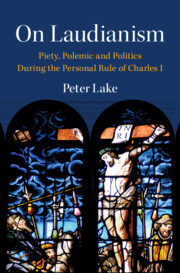Book contents
- On Laudianism
- Cambridge Studies in Early Modern British History
- On Laudianism
- Copyright page
- Contents
- Acknowledgements
- Abbreviations
- Introduction
- Part I Laudianism: Where It Came From
- Chapter 1 A Trinitarian and Incarnational Theology
- Chapter 2 Andrewes’ Political Theology
- Chapter 3 Andrewes’ Anti-Puritanism
- Chapter 4 Puritan Politics
- Chapter 5 The Tree of Repentance and Its Fruits
- Chapter 6 Absent Presences
- Chapter 7 The Visible Church and Its Ordinances
- Part II Laudianism: What It Was
- Part III Laudianism: What It Wasn’t
- Part IV Laudianism and Predestination
- Part V Laudianism as Coalition: The Constituent Parts
- Conclusion
- Index
Chapter 5 - The Tree of Repentance and Its Fruits
from Part I - Laudianism: Where It Came From
Published online by Cambridge University Press: 05 October 2023
- On Laudianism
- Cambridge Studies in Early Modern British History
- On Laudianism
- Copyright page
- Contents
- Acknowledgements
- Abbreviations
- Introduction
- Part I Laudianism: Where It Came From
- Chapter 1 A Trinitarian and Incarnational Theology
- Chapter 2 Andrewes’ Political Theology
- Chapter 3 Andrewes’ Anti-Puritanism
- Chapter 4 Puritan Politics
- Chapter 5 The Tree of Repentance and Its Fruits
- Chapter 6 Absent Presences
- Chapter 7 The Visible Church and Its Ordinances
- Part II Laudianism: What It Was
- Part III Laudianism: What It Wasn’t
- Part IV Laudianism and Predestination
- Part V Laudianism as Coalition: The Constituent Parts
- Conclusion
- Index
Summary
This chapter deals with the positive content of Andrewes’ divinity and the ways in which, through the practice of repentance and of good works, the Christian believer could achieve some sense of his or her own salvation. The works involved were organised under three headings: those of charity, which were directed towards fellow Christians; of piety, directed towards God through divine worship; and of chastisement, directed towards the self in response to sin, of which fasting was the leading example. Thus, in spite of what Andrewes insisted were puritan claims to the contrary, not merely faith but also works, not merely the gospel but also the law, were necessary if salvation were to be achieved. In this way something like a sense of assurance could be achieved, composed in equal parts of fear and security, anxiety and comfort. This was a position constructed (once again) against what Andrewes presented as a false (puritan) assurance, indeed a presumption, based on the false assumption that one was one of the elect.
- Type
- Chapter
- Information
- On LaudianismPiety, Polemic and Politics During the Personal Rule of Charles I, pp. 85 - 92Publisher: Cambridge University PressPrint publication year: 2023



